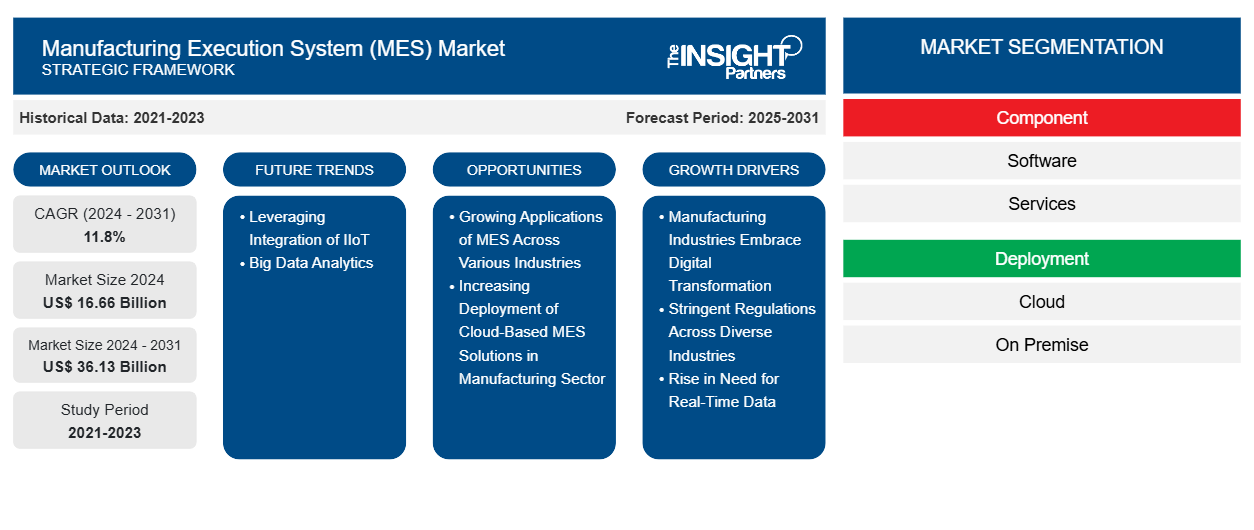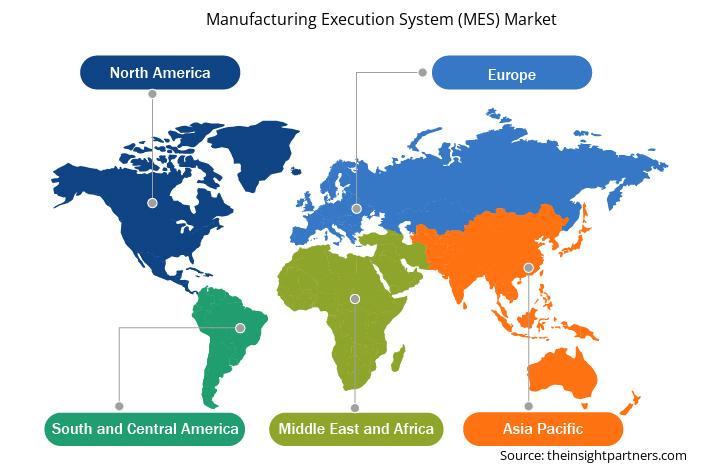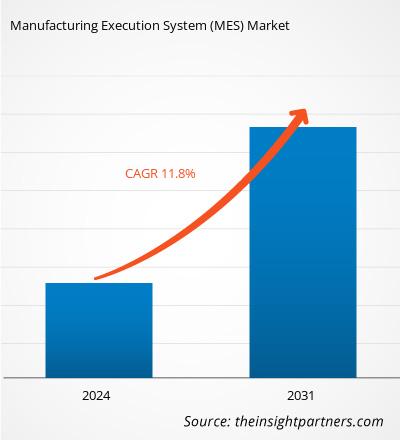Der Markt für Manufacturing Execution Systems (MES) hatte im Jahr 2024 ein Volumen von 16,66 Milliarden US-Dollar und soll bis 2031 36,13 Milliarden US-Dollar erreichen. Für den Zeitraum 2024–2031 wird eine durchschnittliche jährliche Wachstumsrate (CAGR) von 11,8 % erwartet. Die Integration von IIoT und Big Data Analytics dürfte weiterhin ein wichtiger Markttrend bleiben.
Marktanalyse für Manufacturing Execution System (MES)
Faktoren wie die digitale Transformation der Fertigungsindustrie, strenge Regulierungen in verschiedenen Branchen und der steigende Bedarf an Echtzeitdaten treiben das Wachstum des Marktes für Manufacturing Execution Systems (MES) voran . Der zunehmende Einsatz von MES in verschiedenen Branchen und der Aufstieg cloudbasierter MES-Lösungen in der Fertigung dürften Chancen für die Expansion des Marktes für Manufacturing Execution Systems (MES) schaffen. Darüber hinaus dürfte die Integration von IIoT und Big Data Analytics neue Trends für den Markt für Manufacturing Execution Systems (MES) setzen.
Marktübersicht für Manufacturing Execution System (MES)
Ein Manufacturing Execution System (MES) ist ein umfassendes, dynamisches Softwaresystem, das den gesamten Fertigungsprozess – vom Rohstoff bis zum fertigen Produkt – überwacht, verfolgt, dokumentiert und verwaltet. Es fungiert als funktionale Schicht zwischen Enterprise Resource Planning (ERP) und Prozessleitsystemen und liefert Entscheidungsträgern die Daten, die sie zur Verbesserung der Produktionseffizienz benötigen. Mit einem MES können Unternehmen den gesamten Fertigungsprozess – vom Rohstoffeingang bis zur Auslieferung des fertigen Produkts – verfolgen und steuern . Dies umfasst die Bearbeitung von Arbeitsaufträgen, die Überprüfung der Produktqualität, die Überwachung der Maschinenleistung und die Datenerfassung während des gesamten Produktionsprozesses.
Eine MES-Software dient der Verwaltung, Überwachung und Koordination der physischen Prozesse und des Personals in Echtzeit, die an der Umwandlung von Rohstoffen in Zwischenprodukte und/oder Fertigprodukte beteiligt sind. Darüber hinaus liefert sie verwertbare Daten, die Entscheidungsträgern in der Fertigung helfen, die Betriebsbedingungen in der Fabrik zu optimieren und so die Produktionsleistung zu steigern. MES-Software fungiert als Brücke zwischen PLM, ERP-Systemen (IT) und Maschinen (OT). Diese Softwareschicht verbessert die Effizienz und Qualität des Produktionsprozesses und führt so zu höherer Produktivität und Rentabilität.
Passen Sie diesen Bericht Ihren Anforderungen an
Sie erhalten kostenlos Anpassungen an jedem Bericht, einschließlich Teilen dieses Berichts oder einer Analyse auf Länderebene, eines Excel-Datenpakets sowie tolle Angebote und Rabatte für Start-ups und Universitäten
Markt für Manufacturing Execution System (MES): Strategische Einblicke

- Informieren Sie sich über die wichtigsten Markttrends in diesem Bericht.Dieses KOSTENLOSE Beispiel umfasst eine Datenanalyse, die von Markttrends bis hin zu Schätzungen und Prognosen reicht.
Markttreiber und Chancen für Manufacturing Execution System (MES)
Strenge Vorschriften in verschiedenen Branchen
MES gewährleistet die Einhaltung der Branchenvorschriften durch lückenlose Rückverfolgbarkeit und Datenaufzeichnung. Es erfasst umfassende Informationen über die an der Herstellung beteiligten Rohstoffe, Komponenten, Prozesse und Bediener. Diese Daten ermöglichen es Herstellern, regulatorische Kriterien zu erfüllen und hohe Standards einzuhalten. Beispielsweise kann MES jeden Schritt des Herstellungsprozesses automatisch dokumentieren und so einen für behördliche Inspektionen erforderlichen Prüfpfad erstellen. Darüber hinaus analysiert es Qualitätskontrollparameter in Echtzeit, um sicherzustellen, dass die Produkte den Industriestandards entsprechen. Bei Abweichungen kann MES Warnmeldungen senden und Korrekturmaßnahmen ergreifen, um die Einhaltung der Vorschriften zu gewährleisten. MES bildet das Rückgrat des täglichen Betriebs in der Pharmaindustrie und ermöglicht eine präzise Echtzeitverwaltung aller Aspekte des Herstellungsprozesses. In der Pharmaindustrie ermöglicht MES die Erstellung elektronischer Chargenprotokolle (EBR) gemäß den strengen Kriterien der Guten Herstellungspraxis (GMP). Durch den Einsatz eines EBR-Systems stellt MES sicher, dass jeder Produktionsschritt genau dokumentiert wird, wodurch das Risiko menschlicher Fehler reduziert und die tägliche Betriebsverwaltung vereinfacht wird. Darüber hinaus erfüllen MES in der Lebensmittel- und Getränkeindustrie alle gesetzlichen und hygienischen Standards, einschließlich der Gefahrenanalyse und kritischer Kontrollpunkte (HACCP). Die Einführung von MES in der Lebensmittel- und Getränkeindustrie erfolgt am besten schrittweise, beginnend mit ausgewählten Produktionslinien oder -bereichen, um Störungen im Herstellungsprozess zu minimieren. Strenge regulatorische Standards in verschiedenen Branchen treiben daher das Marktwachstum für Manufacturing Execution Systems (MES) voran.
Zunehmende MES-Anwendungen in verschiedenen Branchen
MES-Lösungen lassen sich an die spezifischen Anforderungen verschiedener Branchen wie der Automobil-, Elektronik- und Pharmaindustrie anpassen. Die Grundfunktion eines MES bleibt dabei branchenübergreifend gleich. Eine Manufacturing Execution System (MES)-Lösung kann helfen, mit der zunehmend komplexen und sich schnell verändernden Automobilindustrie Schritt zu halten und die Fertigungsabläufe besser an die Marktanforderungen anzupassen. Ein MES nutzt hierfür drei Schlüsselfunktionen: Betriebsführung, Informationsmanagement und Integrationsgateway. Der Einsatz eines MES kann Automobilzulieferern helfen, den sich verändernden Branchentrends immer einen Schritt voraus zu sein. In der Automobilproduktion spielt ein MES eine entscheidende Rolle bei der Koordination komplexer Montagelinien. Ein MES verfolgt den Fortschritt der Fahrzeuge am Fließband, überwacht die Verfügbarkeit von Komponenten und synchronisiert Abläufe über verschiedene Arbeitsstationen hinweg. Batteriehersteller können ihr Qualitätsmanagement durch lückenlose Rückverfolgbarkeit von der Mischung bis zur Formulierung verbessern. Reifenhersteller können Effizienz- und Qualitätsstandards einhalten und gleichzeitig komplexe Reifenmischungen verarbeiten. Ein MES kann in vielen Bereichen messbare Verbesserungen liefern. Laut Rockwell Automation kann MES den Ausschuss um bis zu 8 %, die Durchlaufzeit um bis zu 45 %, die Zykluszeit um bis zu 45 %, die Arbeitskosten um bis zu 50 % und die Ausschussrate um bis zu 75 % reduzieren. Daher findet es Anwendung in verschiedenen Branchen. Daher wird erwartet, dass die zunehmende Anwendung von MES in verschiedenen Branchen lukrative Möglichkeiten für das Marktwachstum schafft.
Segmentierungsanalyse des Manufacturing Execution System (MES)-Marktberichts
Wichtige Segmente, die zur Ableitung der Marktanalyse für Manufacturing Execution System (MES) beigetragen haben, sind Komponente, Bereitstellung, Organisationsgröße, Lizenztyp, Vertriebskanal und Endbenutzer.
- Basierend auf den Komponenten ist der Markt in Software und Service segmentiert. Das Servicesegment ist weiter in Professional Services und Managed Services unterteilt. Das Softwaresegment dominierte den Markt im Jahr 2024.
- Hinsichtlich der Bereitstellung ist der Markt in On-Premise und Cloud segmentiert. Das Cloud-Segment ist weiter in Private Cloud, Public Cloud und Hybrid Cloud unterteilt. Die Cloud hatte im Jahr 2024 den größten Marktanteil.
- Der Markt für Manufacturing Execution System (MES) ist nach Unternehmensgröße in Großunternehmen und KMU unterteilt. Das Segment der Großunternehmen dominierte den Markt im Jahr 2024.
- Basierend auf dem Lizenztyp ist der Markt für Manufacturing Execution System (MES) in lizenzierte und abonnementbasierte Lizenzen segmentiert. Das abonnementbasierte Segment dominierte den Markt im Jahr 2024.
- Basierend auf den Vertriebskanälen wird der Markt in Direktvertrieb, Vertriebspartner und Drittanbieter unterteilt. Das Direktvertriebssegment dominierte den Markt im Jahr 2024.
- Basierend auf dem Endverbraucher ist der Markt in die Prozessindustrie und die diskrete Industrie segmentiert. Die Prozessindustrie ist weiter unterteilt in Lebensmittel und Getränke, Öl und Gas, Chemie, Zellstoff und Papier, Chemie, Energie und Strom, Pharmazeutika und Biowissenschaften, Wasser- und Abwasseraufbereitung und Sonstiges. Die diskrete Industrie ist weiter segmentiert in Automobil, Elektronik, Halbleiter, Luft- und Raumfahrt und Verteidigung, Konsumgüter, Medizinprodukte und Sonstiges. Die diskrete Industrie dominierte den Markt im Jahr 2024.
Manufacturing Execution System (MES) Marktanteilsanalyse nach Geografie
- Der Markt für Manufacturing Execution Systems (MES) ist in fünf Hauptregionen unterteilt: Nordamerika, Europa, Asien-Pazifik (APAC), Naher Osten und Afrika (MEA) sowie Süd- und Mittelamerika. Nordamerika dominierte den Markt für Manufacturing Execution Systems (MES) im Jahr 2024. Europa leistet den zweitgrößten Beitrag zum globalen Markt für Manufacturing Execution Systems (MES), gefolgt vom Asien-Pazifik-Raum.
- Der Markt für Manufacturing Execution Systems (MES) in Nordamerika ist in die USA, Kanada und Mexiko unterteilt. Nordamerika hält einen bedeutenden Marktanteil im Bereich Manufacturing Execution Systems (MES), der auf die fortschrittliche Fertigungsbasis der Region und die frühe Einführung von Industrie 4.0-Technologien zurückzuführen ist. Insbesondere die USA sind Sitz vieler MES-Softwareanbieter, darunter weltweit führende Unternehmen wie Rockwell Automation und Honeywell International Inc. MES werden in Nordamerika in Branchen wie der Automobilindustrie, der Luft- und Raumfahrt, der Pharmaindustrie und der Elektronik eingesetzt. Die zunehmende Bedeutung von Echtzeit-Datenanalyse, Produktionseffizienz und Einhaltung gesetzlicher Vorschriften treibt die Nachfrage nach MES-Lösungen an. Darüber hinaus verzeichnet der nordamerikanische Markt ein erhebliches Wachstum, da Hersteller und Behörden zunehmend die Vorteile der Echtzeit-Produktionsüberwachung und Prozessoptimierung erkennen. Staatliche Anreize für die digitale Transformation und die Einführung von Industrie 4.0 beschleunigen die Nachfrage nach MES-Systemen und kurbeln das Marktwachstum weiter an.
Regionale Einblicke in den Markt für Manufacturing Execution System (MES)
Die Analysten von Insight Partners haben die regionalen Trends und Faktoren, die den Markt für Manufacturing Execution Systeme (MES) im Prognosezeitraum beeinflussen, ausführlich erläutert. Dieser Abschnitt behandelt außerdem die Marktsegmente und die geografische Lage von Manufacturing Execution Systemen (MES) in Nordamerika, Europa, Asien-Pazifik, dem Nahen Osten und Afrika sowie Süd- und Mittelamerika.

- Erhalten Sie regionale Daten zum Manufacturing Execution System (MES)-Markt
Umfang des Marktberichts Manufacturing Execution System (MES)
| Berichtsattribut | Details |
|---|---|
| Marktgröße im Jahr 2024 | 16,66 Milliarden US-Dollar |
| Marktgröße bis 2031 | 36,13 Milliarden US-Dollar |
| Globale CAGR (2024 – 2031) | 11,8 % |
| Historische Daten | 2021-2023 |
| Prognosezeitraum | 2025–2031 |
| Abgedeckte Segmente | Nach Komponente
|
| Abgedeckte Regionen und Länder | Nordamerika
|
| Marktführer und wichtige Unternehmensprofile |
|
Marktteilnehmerdichte für Manufacturing Execution System (MES): Auswirkungen auf die Geschäftsdynamik
Der Markt für Manufacturing Execution Systeme (MES) wächst rasant. Die steigende Nachfrage der Endnutzer ist auf Faktoren wie veränderte Verbraucherpräferenzen, technologische Fortschritte und ein stärkeres Bewusstsein für die Produktvorteile zurückzuführen. Mit der steigenden Nachfrage erweitern Unternehmen ihr Angebot, entwickeln Innovationen, um den Bedürfnissen der Verbraucher gerecht zu werden, und nutzen neue Trends, was das Marktwachstum weiter ankurbelt.
Die Marktteilnehmerdichte beschreibt die Verteilung der in einem bestimmten Markt oder einer bestimmten Branche tätigen Unternehmen. Sie gibt an, wie viele Wettbewerber (Marktteilnehmer) in einem bestimmten Marktraum im Verhältnis zu dessen Größe oder Gesamtmarktwert präsent sind.
Die wichtigsten Unternehmen auf dem Markt für Manufacturing Execution Systeme (MES) sind:
- SAP SE
- ABB Ltd
- Dassault Systemes SE
- Schneider Electric SE
- Emerson Electric Co
- General Electric Co
Haftungsausschluss : Die oben aufgeführten Unternehmen sind nicht in einer bestimmten Reihenfolge aufgeführt.

- Überblick über die wichtigsten Akteure auf dem Manufacturing Execution System (MES)-Markt
Neuigkeiten und aktuelle Entwicklungen zum Manufacturing Execution System (MES)-Markt
Der Markt für Manufacturing Execution Systems (MES) wird durch die Erhebung qualitativer und quantitativer Daten aus Primär- und Sekundärforschung bewertet, die wichtige Unternehmenspublikationen, Verbandsdaten und Datenbanken umfasst. Nachfolgend sind einige Entwicklungen im Markt für Manufacturing Execution Systems (MES) aufgeführt:
- Emerson Automation Solutions gab bekannt, dass es seine Partnerschaft mit Informetric Systems Inc. erweitert hat. Emerson hat InfoBatch in das Syncade Manufacturing Execution System integriert. Emerson-Kunden können nun Daten aus Syncade, DeltaV und Datenbanken/Historikern von Drittanbietern mithilfe der InfoBatch-Berichtssuite aggregieren.
(Quelle: Emerson Automation Solutions, Pressemitteilung, November 2024)
- GE Digital, ein integraler Bestandteil des Energieportfolios von GE Vernova, kündigte auf dem 27. jährlichen ARC Industry Forum vom 6. bis 9. Februar in Orlando, Florida, neue Erweiterungen seiner cloudbasierten Manufacturing Execution Systems (MES)-Software im Proficy Smart Factory-Portfolio an. Die Proficy Smart Factory Cloud-MES-Software senkt die Investitions- (CAPEX) und Betriebskosten (OPEX) im Vergleich zu lokalen Implementierungen und unterstützt Prozess-, diskrete und gemischte Fertigungsumgebungen jeder Größe dabei, die Gesamtbetriebskosten (TCO) um bis zu 30 % zu senken, den Wartungsaufwand zu reduzieren und die Sicherheit zu verbessern.
(Quelle: GE Digital, Pressemitteilung, Februar 2023)
Marktbericht zum Manufacturing Execution System (MES): Umfang und Ergebnisse
Der Bericht „Manufacturing Execution System (MES)-Marktgröße und -prognose (2021–2031)“ bietet eine detaillierte Analyse des Marktes, die die unten genannten Bereiche abdeckt:
- Marktgröße und Prognose für Manufacturing Execution System (MES) auf globaler, regionaler und Länderebene für alle wichtigen Marktsegmente, die im Rahmen des Berichts abgedeckt sind
- Markttrends im Bereich Manufacturing Execution System (MES) sowie Marktdynamiken wie Treiber, Einschränkungen und wichtige Chancen
- Detaillierte PEST- und SWOT-Analyse
- Marktanalyse für Manufacturing Execution System (MES), die wichtige Markttrends, globale und regionale Rahmenbedingungen, wichtige Akteure, Vorschriften und aktuelle Marktentwicklungen umfasst
- Branchenlandschafts- und Wettbewerbsanalyse mit Marktkonzentration, Heatmap-Analyse, prominenten Akteuren und jüngsten Entwicklungen für den Markt für Manufacturing Execution System (MES)
- Detaillierte Firmenprofile
- Historische Analyse (2 Jahre), Basisjahr, Prognose (7 Jahre) mit CAGR
- PEST- und SWOT-Analyse
- Marktgröße Wert/Volumen – Global, Regional, Land
- Branchen- und Wettbewerbslandschaft
- Excel-Datensatz
Aktuelle Berichte
Erfahrungsberichte
Grund zum Kauf
- Fundierte Entscheidungsfindung
- Marktdynamik verstehen
- Wettbewerbsanalyse
- Kundeneinblicke
- Marktprognosen
- Risikominimierung
- Strategische Planung
- Investitionsbegründung
- Identifizierung neuer Märkte
- Verbesserung von Marketingstrategien
- Steigerung der Betriebseffizienz
- Anpassung an regulatorische Trends




















 Kostenlose Probe anfordern für - Markt für Manufacturing Execution System (MES)
Kostenlose Probe anfordern für - Markt für Manufacturing Execution System (MES)